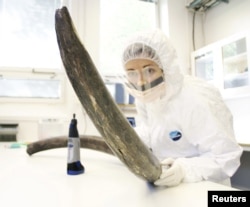The most complete genetic information assembled on woolly mammoths is providing insight into their demise, revealing they suffered two population crashes before a final, severely inbred group succumbed on an Arctic Ocean island.
Scientists unveiled on Thursday the first two full genomes of these mighty elephant relatives emblematic of the Ice Age, showing they experienced an extensive loss of genetic diversity before perishing roughly 4,000 years ago.
Well-preserved DNA came from two mammoths: a 45,000-year-old calf carcass from Siberia and a 4,300-year-old molar from a mammoth in the last population isolated on remote Wrangel Island, off the Russian mainland. Inbreeding was detected in the Wrangel Island mammoth.
"The individual from Wrangel Island, which was one of the last surviving woolly mammoths in the world, had a much lower genetic variation compared to the other, more ancient individual,'' said Swedish Museum of Natural History geneticist Love Dalen.
"The reason for this difference is that the Wrangel individual's genome contained a large number of tracts with no variation at all, which is a pattern that is typical in very small populations where most matings occur between distant relatives,'' she said.
The woolly mammoth, about the size of today's elephants but with long brown fur and colossal tusks, first appeared 700,000 years ago in Siberia, expanding through northern Eurasia and North America. Whether their extinction resulted from a warming climate or human hunting remains hotly debated.
Harvard Medical School geneticist Eleftheria Palkopoulou said the genomes indicated two major population crashes: one around 280,000 years ago from which the population recovered, and a second about 12,000 years ago, near the Ice Age's end, from which it did not.
After the second one, an estimated 300 to 1,000 mammoths survived. A small Wrangel Island population existed for about 6,000 years after all mainland mammoths had died. The inbreeding probably harmed the population's viability and contributed to its extinction, Dalen said.
The researchers acknowledged the genomes could guide efforts by others to resurrect the mammoth through cloning, creating a mammoth embryo in a lab and using an elephant as a surrogate mother.
"Before answering whether this will be feasible in the near future, there are important ethical questions that need to be considered first,'' Palkopoulou said. "How many mammoths would be needed to sustain a viable population? Wouldn't resources be better used to conserve living species and sustain their habitats?''
The research appears in the journal Current Biology.










